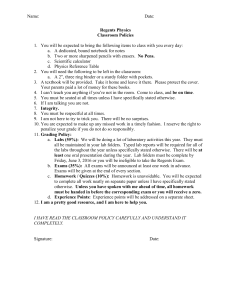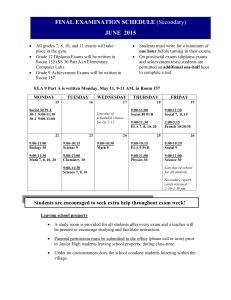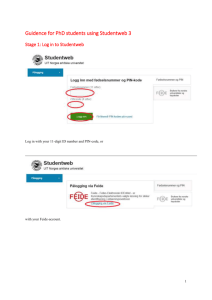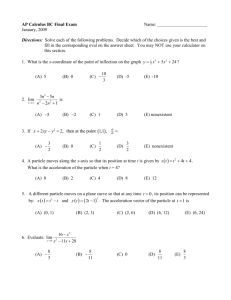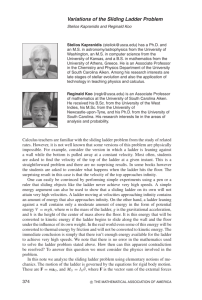Calculus B – Practice Problems for Final Exam
advertisement
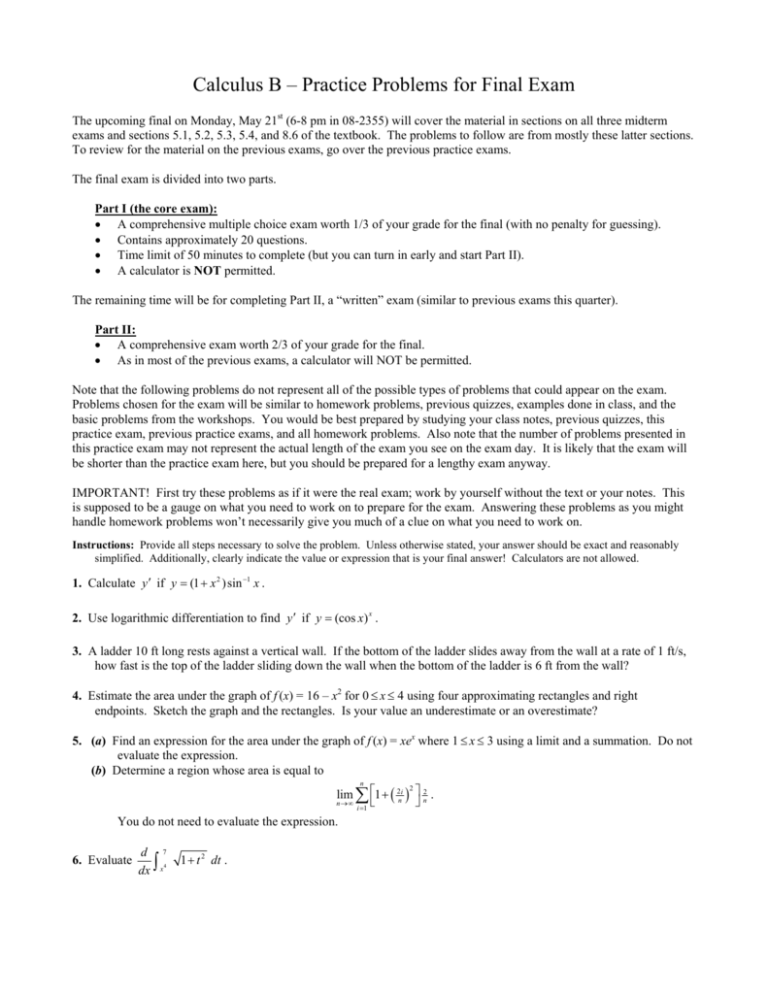
Calculus B – Practice Problems for Final Exam The upcoming final on Monday, May 21st (6-8 pm in 08-2355) will cover the material in sections on all three midterm exams and sections 5.1, 5.2, 5.3, 5.4, and 8.6 of the textbook. The problems to follow are from mostly these latter sections. To review for the material on the previous exams, go over the previous practice exams. The final exam is divided into two parts. Part I (the core exam): A comprehensive multiple choice exam worth 1/3 of your grade for the final (with no penalty for guessing). Contains approximately 20 questions. Time limit of 50 minutes to complete (but you can turn in early and start Part II). A calculator is NOT permitted. The remaining time will be for completing Part II, a “written” exam (similar to previous exams this quarter). Part II: A comprehensive exam worth 2/3 of your grade for the final. As in most of the previous exams, a calculator will NOT be permitted. Note that the following problems do not represent all of the possible types of problems that could appear on the exam. Problems chosen for the exam will be similar to homework problems, previous quizzes, examples done in class, and the basic problems from the workshops. You would be best prepared by studying your class notes, previous quizzes, this practice exam, previous practice exams, and all homework problems. Also note that the number of problems presented in this practice exam may not represent the actual length of the exam you see on the exam day. It is likely that the exam will be shorter than the practice exam here, but you should be prepared for a lengthy exam anyway. IMPORTANT! First try these problems as if it were the real exam; work by yourself without the text or your notes. This is supposed to be a gauge on what you need to work on to prepare for the exam. Answering these problems as you might handle homework problems won’t necessarily give you much of a clue on what you need to work on. Instructions: Provide all steps necessary to solve the problem. Unless otherwise stated, your answer should be exact and reasonably simplified. Additionally, clearly indicate the value or expression that is your final answer! Calculators are not allowed. 1. Calculate y if y (1 x 2 ) sin 1 x . 2. Use logarithmic differentiation to find y if y (cos x) x . 3. A ladder 10 ft long rests against a vertical wall. If the bottom of the ladder slides away from the wall at a rate of 1 ft/s, how fast is the top of the ladder sliding down the wall when the bottom of the ladder is 6 ft from the wall? 4. Estimate the area under the graph of f (x) = 16 – x2 for 0 x 4 using four approximating rectangles and right endpoints. Sketch the graph and the rectangles. Is your value an underestimate or an overestimate? 5. (a) Find an expression for the area under the graph of f (x) = xex where 1 x 3 using a limit and a summation. Do not evaluate the expression. (b) Determine a region whose area is equal to n 2 lim 1 2ni n2 . n i 1 You do not need to evaluate the expression. 6. Evaluate d 7 4 dx x 1 t 2 dt . 7. Let g ( x) x 0 x, f (t )dt where f ( x) 1, 3 x, if x 1; if 1 x 2; if x 2; (a) Determine each of the following: (i) g(1); (ii) g(0); (iii) g(1); (iv) g(2); (v) g(3). (b) For what values is g discontinuous? (c) For what values is g not differentiable? 8. Evaluate each of the following: (a) 2 1 1 x x dx ; (b) 2 4 x x dx . 4 x 2 , if x 2 x 2; 9. The function f is defined on the interval [-2, 6] and is given by f ( x) if 2 x 6. x 2, Estimate the area under the graph of f by calculating (a) R4, (b) T4, (c) M4, and (d) S4. Exercises from the text. I would STONGLY recommend that you try as many of these problems as you can. Any of these problems (or ones similar to them) could appear on the exam. If you don’t have time to do all of these, I would recommend focusing on the problems that are underlined and boldfaced in red. Chapter 5 Practice Exercises (pg 354-357): 1, 9, 11, 13, 73, 75, 77, 85, 89, 95, 121, 123, 127 Calculus B – Answers to Practice Problems for Final Exam 1. y 2 x sin 1 x 1 x2 1 x2 2. y (cos x ) x ln cos x x tan x 3. -3/4 ft/s 4. The estimate is 34. It is an underestimate. n 5. (a) lim 1 2ni e1 2i / n n i 1 2 n (b) The region is below the function f (x) = 1 + x2 and above the x-axis where x is between 0 and 2. 6. 4 x 3 1 x8 7. (a) (i) g(-1) = -0.5 (ii) g(0) = 0 (iii) g(1) = 0.5 (iv) g(2) = 1.5 (v) g(3) = 2 (b) g is continuous for all real numbers. (c) g is differentiable for all real numbers. 8. (a) 29/6 (b) 8x1/ 2 23 x 3/ 2 C 9. (a) R4 = 20, (b) T4 = 16, (c) M4 = 20, and (d) S4 = 56/3.


